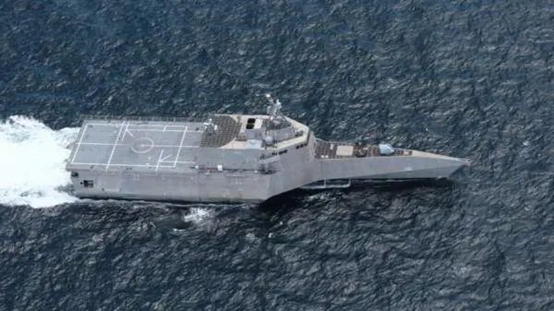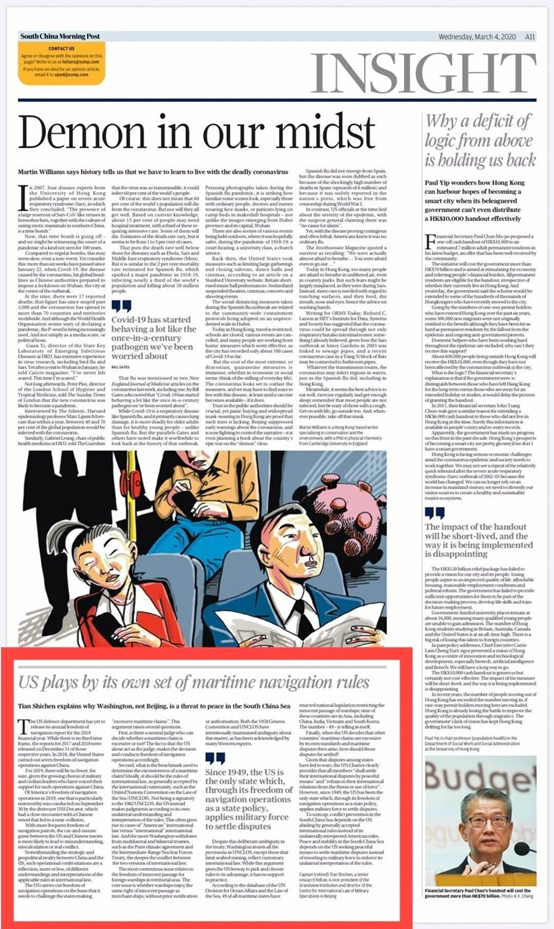3月4日,《南华早报》发表CISS中国论坛特约专家田士臣文章。经作者许可,现将文章中英文原文刊登如下:
美国国防部尚未发布2019财年的年度航行自由报告。此报告的发布虽没有固定日期,但2017年和2018年的报告分别于当年的12月31日发布。2018年,美国针对中国实施了七次航行自由行动。鉴于越来越多的美国军队和政府领导人对此类行动表示支持,2019年的航行自由行动与上一年比起来应该有增无减。
在美国2019年的航行自由行动中,9月30日由驱逐舰“迪凯特”号实施的那次尤为值得关注,当时该舰与一艘中国船只险些相撞。随着航行自由巡逻的日益频繁,中美海军之间猫捉老鼠的游戏很可能会导致双方的误解、误判甚至真正的冲突。尽管中美之间存在战略和地缘政治竞争,但这种行动上的对抗或多或少地反映出双方对国际法规则适用的理解有所不同。

| 1月25日,美国海军濒海战斗舰“蒙哥马利”号擅闯我南海岛礁邻近海域(资料图)
美国实施航行自由行动是基于对提出“过度海洋主张”的国家发起挑战的立场,然而这样的想法和立场存在以下几个问题:
首先,是否存在一个公正、中立的法官可以裁决海洋主张是否过度?如今的局面是,美国自己充当法官一角,作出判断,并据此实施航行自由行动。
第二,用来衡量海洋主张是否过度的标准是什么?理想情况下,它应该是国际社会普遍接受的国际法规则,例如《联合国海洋法公约》。美国并不是1982年《联合国海洋法公约》的签署国,只是根据自己单方面对规则的解读妄下定论。这种做法导致美国版国际法与真正国际社会普遍适用的国际法之间屡屡发生冲突,美国越是退出各大国际多双边协议,比如《巴黎协定》和《中程核力量条约》,两个版本的国际法之间冲突就越深。
最具争议性的,当属外国船舶穿越一国领海的无害通过权问题,其关键在于,军舰是否享有与商船同样的无害通过权,而无需事先通知或授权。1958年《日内瓦领海和毗连区公约》和1982年《联合国海洋法公约》在这个问题上都有意保持模糊,没有做出明文规定,这也被许多西方专家所承认。
尽管条约规定刻意保持了模糊,美国却坚持认为,除了限制海底采矿的条款外,《联合国海洋法公约》的所有条款都反映了国际习惯法的规定。尽管这一观点给了美国很大余地,使其可以挑选对其有利的规则,但在实践中他们却没有得到支持。联合国海洋事务与海洋法总署的数据显示,世界上49个海洋国家都颁布了限制军舰无害通过的国内法,其中包括中国、印度、越南和韩国等9个亚洲国家。单是49这个数字本身就很能说明问题。
伊莱休·鲁特曾在西奥多·罗斯福总统时期担任美国国务卿,并在北大西洋海岸渔业仲裁案中作为律师代表美国。他曾说:“军舰不得在未经同意的情况下进入该区域,因为它们会造成威胁。而商船可以往返通过,因为它们不会造成威胁。”

此外,美国还指责中国阻碍了南海的航行自由。事实上,没有任何报道显示该地区商船往来受到过阻碍,经由南海的海运贸易未曾受过任何影响。但是,美国官方及媒体报道却运用一些卓有成效的小把戏来故意混淆军事航行和商业航行的规则。
最后一个问题,当美国根据自己的标准判定其他国家的海洋主张是过度的,进而引发海洋争端时,这些纠纷应该如何解决?鉴于国家间的争端常常引发战争,《联合国宪章》明确规定,“……所有成员国应以和平手段解决其国际争端……”,以及“……所有成员国在其国际关系中不得使用威胁或武力”。然而,自1949年以来,美国一直是唯一一个通过其作为国家政策的航行自由行动,运用军事力量解决争端的国家。
总而言之,防止南海发生冲突的关键,在于美国能否遵循国际社会普遍接受的国际规则,而不是美国自己对规则的单方面解读。南海的和平与稳定取决于美国是否愿意寻求和平手段解决海洋争端,而不是诉诸武力,强制执行由其单方面解读的规则。

US plays by its own set of maritime navigational rules
Tian Shichen explains why Washington, not Beijing, is a threat to peace in the South China Sea
The US defence department has yet to release its annual freedom of navigation report for the 2019 financial year. While there is no fixed time frame, the reports for 2017 and 2018 were released on December 31st of those respective years. In 2018, the United States carried out seven freedom of navigation operations against China.
For 2019, there will be no fewer, for sure, given the growing chorus of military and civilian leaders who have voiced their support for such operations against China.
Of the US’ freedom of navigation operations in 2018, one that is particularly note worthy was conducted on September 30th by the destroyer USS Decatur, which had a close encounter with a Chinese vessel that led to a near-collision.
With more frequent freedom of navigation patrols, the cat-and-mouse game between the US and Chinese navies is more likely to lead to misunderstanding, miscalculation or real conflict.
Not with standing the strategic and geopolitical competition between China and the US, such operational confrontations are a reflection, more or less, of different understandings and interpretations of the applicable rules in international law.
The US carries out freedom of navigation operations on the basis that it needs to challenge the states making “excessive maritime claims”. This argument raises several questions.
First, is there a neutral judge who can decide whether a maritime claim is excessive or not? The fact is that the US alone act as the judge, makes the decision and conducts freedom of navigation operations accordingly.
Second, what is the benchmark used to determine the excessiveness of a maritime claim? Ideally, it should be the rules of international law, as generally accepted by the international community, such as the United Nations Convention on the Law of the Sea (UNCLOS).
Not being a signatory to the 1982 UNCLOS, the US instead makes its own judgments according to its own unilateral understanding and interpretation of the rules. This oftengives rise to cases of American international law versus international international law.
And the more the US withdraws from multilateraland bilateral treaties, such as the Paris climate agreement and the Intermediate-Range Nuclear Forces Treaty, the deeper the c
The most contentious issue relates to the freedom of innocent passage for foreign warships in territorial seas. The core issue is whether warships enjoy the same right of innocent passage as merchant ships, without prior notification or authorisation. Both the 1958 Geneva Convention and UNCLOS have intentionally maintained ambiguity about this matter, as has been acknowledged by many Western experts.
Despite this deliberate ambiguity in the treaty, the US insists that all the provisions in UNCLOS, except for those that limit seabed mining, reflect customary international law. While this argument gives the US leeway to pick and choose rules to its advantage, it has no support in practice.
According to the database of the UN Division for Ocean Affairs and the Law of the Sea, 49 of all maritime states have enacted national legislation restricting the innocent passage of warships; nine of these countries are in Asia, including China, India, Vietnam and South Korea. Thenumber – 49 – is telling in itself.
Elihu Root, who served as US secretary of state under President Theodore Roosevelt, represented the US in the North Atlantic Coast Fisheries case. He said: “Warships may not pass without consent into this zone because they threaten. Merchant ships may pass and repass because they do not threaten.”
The US also accuses China of impeding freedom of navigation in the South China Sea. Yet, the fact is that there has been no report of any impeding of merchant ships in the region. Seaborne trade via the South China Sea has been in no way affected. Once again, a small, but effective, trick is being played to deliberately conflate the rules of military and commercial navigation, whether in the official US line or media reports.
Finally, when the US decides that other countries’ maritime claims are excessive by its own standards and maritime disputes then arise, how should those disputes be settled?
Given that disputes among states have often led to wars, the UN Charter clearly provides that “… all Members shall settle their international disputes by peaceful means…” and “… all members shall refrain in their international relations from the threat or use of force”. However, since 1949, the US has been the only state which, through its freedom of navigation operations as a state policy, applies military force to settle disputes.
To sum up, conflict prevention in the South China Sea depends on the US abiding by generally accepted international rules instead of its unilaterally interpreted American rules. Peace and stability in the South China Sea depends on the US seeking peaceful means to settle maritime disputes instead of resorting to military force to enforce its unilateral interpretation of the rules.
田士臣:国观智库副总裁兼国际军事行动法研究中心主任、CISS中国论坛特约专家
文章中译文首发观察者网

